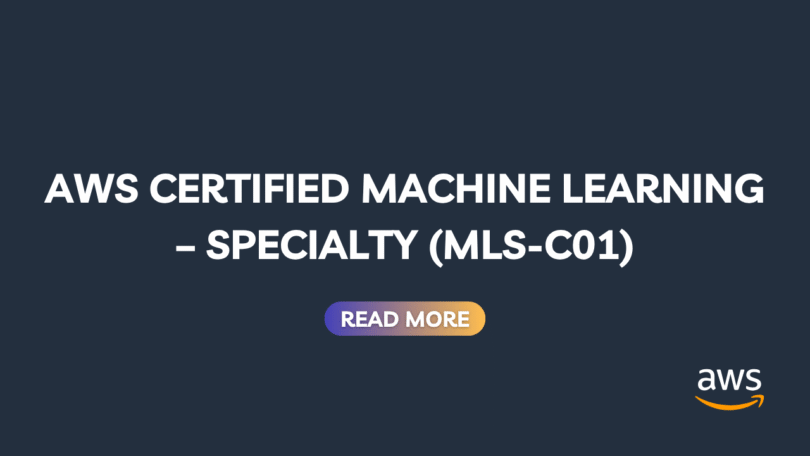The AWS Certified Machine Learning – Specialty (MLS-C01) certification is for professionals who build, train, tune, and deploy machine learning models on AWS. This exam showcases your ability to design and implement scalable, cost-optimized, and secure ML solutions. It’s one of the most challenging certifications, requiring a deep understanding of the entire ML lifecycle. To pass, you need rigorous practice, and our MLS-C01 mock test is designed for exactly that.
Our full-length practice exam simulates the real MLS-C01 test, with questions weighted across the key domains of Data Engineering, Exploratory Data Analysis, Modeling, and ML Implementation and Operations. When you take our AWS Machine Learning Specialty practice exam, you’ll be challenged on everything from data ingestion with Kinesis and ETL with AWS Glue, to model training with Amazon SageMaker, hyperparameter tuning, and operationalizing models with MLOps best practices. Each question includes a detailed explanation to help you master the concepts, not just memorize answers.
From feature engineering to detecting data drift, the MLS-C01 exam covers a vast landscape. Our mock test provides the focused practice you need to identify your knowledge gaps and build confidence. You’ll gain hands-on experience with the types of complex scenarios you’ll face on exam day. If you’re ready to prove your expertise in machine learning on AWS, our comprehensive practice exam is your launchpad to success.
For the most accurate and detailed information, always refer to the official AWS MLS-C01 Exam Guide.
This is a timed quiz. You will be given 10800 seconds to answer all questions. Are you ready?
Root Mean Squared Error (RMSE) is a standard metric for evaluating regression models. It measures the average magnitude of the errors between predicted and actual values, with larger errors being penalized more heavily due to the squaring operation.
A key component of a robust MLOps strategy is a central repository to store, version, and share trained machine learning models. Which SageMaker feature serves this purpose?
The Amazon SageMaker Model Registry is a purpose-built repository for machine learning models. It allows you to catalog models, manage model versions, associate metadata like performance metrics with them, and manage the approval status of models before deployment. It is a central component for CI/CD and MLOps workflows.
A team is using a custom container with their own algorithm for training in SageMaker. What must the container implement to be compatible with SageMaker?
To be compatible with SageMaker, a custom container must implement a specific web server that responds to `/invocations` (for inference) and `/ping` (for health checks). For training, it must contain the training script and be able to read hyperparameters and data locations from environment variables and specific file paths that SageMaker provides.
An ML team has deployed a TensorFlow model to a real-time inference endpoint using Amazon SageMaker. They need to monitor the endpoint’s performance, specifically the number of prediction errors (4xx errors) and faults (5xx errors). They want to create an alarm that triggers if the error rate exceeds a certain threshold. Which service should they use to create this alarm?
Amazon SageMaker endpoints automatically publish a variety of metrics to Amazon CloudWatch, including `ModelError` (4xx) and `SystemError` (5xx). Amazon CloudWatch is the native AWS monitoring service that allows you to create alarms based on these metrics. You can set a threshold on the error count or a metric math expression for the error rate and trigger an action, like an SNS notification, when the threshold is breached.
A dataset for a credit approval model contains a categorical feature `employment_type` with values `full-time`, `part-time`, `contractor`, and `unemployed`. How should this feature be transformed for use in a linear model?
Linear models cannot interpret categorical strings directly. One-hot encoding is the standard technique to convert a categorical feature into a numerical format. It creates a new binary (0 or 1) column for each category, preventing the model from assuming an incorrect ordinal relationship between the categories.
A company wants to understand potential bias in their lending model before deploying it. They need to check if the model’s predictions are equitable across different demographic groups (e.g., age, gender). Which SageMaker feature is designed to analyze pre-training and post-training bias?
Amazon SageMaker Clarify provides tools to help customers detect potential bias in their machine learning models. It can check for bias in the initial dataset (pre-training bias) and in the trained model (post-training bias), and also provides feature importance explanations (explainability).
A team needs to find the optimal set of hyperparameters for their custom algorithm running in SageMaker. They have a limited budget and want to find a good model as quickly as possible. Which tuning strategy should they choose for their hyperparameter tuning job?
Bayesian optimization is generally more efficient than random search. It uses the results from previous training jobs to inform which set of hyperparameters to try next, focusing on more promising areas of the search space. This often leads to finding a better model with fewer training jobs compared to a random search.
A company wants to optimize a trained model for inference on edge devices with limited compute power, such as a Raspberry Pi. The goal is to reduce the model’s footprint and improve performance without sacrificing too much accuracy. Which SageMaker feature should be used?
Amazon SageMaker Neo compiles and optimizes trained models to perform at up to twice the speed with less than a tenth of the memory footprint, with no loss in accuracy. It can compile models for specific target hardware, including many edge devices, making it ideal for optimizing models for resource-constrained environments.
To build a fraud detection model, a data scientist has a highly imbalanced dataset where only 1% of transactions are fraudulent. If they train a model on this raw data, what is a likely outcome?
With a highly imbalanced dataset, a model can achieve high accuracy simply by always predicting the majority class (non-fraudulent). This makes accuracy a poor metric. The model will have high bias towards the majority class and will perform poorly at its actual goal: detecting the rare fraudulent cases.
A company processes streaming data using Amazon Kinesis. They need to ensure that personally identifiable information (PII) within the data stream is redacted before it is stored in Amazon S3 for long-term analysis. The solution should be serverless. Which architecture is most appropriate?
Kinesis Data Firehose can invoke a Lambda function for data transformation before delivering the data to its destination. The Lambda function can contain the logic to inspect each record, identify and redact PII using services like Amazon Comprehend or custom logic, and then return the transformed record to Firehose for delivery to S3.
A machine learning specialist is training a gradient boosting model using the Amazon SageMaker XGBoost algorithm. They are concerned about overfitting. Which hyperparameter should they tune to directly control the complexity of the individual trees in the model and thus reduce overfitting?
`max_depth` is a key hyperparameter in tree-based models like XGBoost. It controls the maximum depth of each decision tree. A smaller `max_depth` creates simpler trees that are less likely to overfit the training data by capturing noise. It's one of the most effective ways to regularize the model.
An ML team needs to automate their entire machine learning workflow, from data preparation and model training to deployment and monitoring. The workflow has multiple steps with dependencies. They want a service to orchestrate this entire MLOps pipeline. Which service should they use?
Amazon SageMaker Pipelines is a purpose-built, easy-to-use continuous integration and continuous delivery (CI/CD) service for machine learning. It allows you to create, automate, and manage end-to-end ML workflows at scale, orchestrating steps like data preparation, model training, hyperparameter tuning, and model deployment.
A company wants to use Amazon S3 as a data lake. How can they enforce encryption for all new objects uploaded to a specific bucket?
A bucket policy can enforce specific conditions on objects being uploaded. By creating a policy that denies the `s3:PutObject` action if the `x-amz-server-side-encryption` request header is not present or not set to a required value (e.g., `AES256`), you can ensure that all new objects are encrypted at rest.
A data scientist is preparing a dataset using a SageMaker notebook. They want to create an interactive dashboard to share their EDA findings with business stakeholders who are not technical. Which AWS service integrates well with SageMaker for this purpose?
Amazon QuickSight is a scalable, serverless, embeddable, machine learning-powered business intelligence (BI) service built for the cloud. Data scientists can easily connect QuickSight to their data sources (like Athena tables created from their EDA process) to create interactive dashboards and visualizations that can be shared with business users.
A company has deployed a machine learning model that predicts customer churn. Over time, the model’s accuracy has degraded significantly. An investigation reveals that the statistical properties of the incoming data (e.g., customer behavior patterns) have changed since the model was trained. What is the term for this phenomenon, and which SageMaker feature is designed to detect it?
Data drift is the phenomenon where the statistical properties of the production data change over time compared to the training data, leading to model performance degradation. Amazon SageMaker Model Monitor is specifically designed to detect data drift by periodically comparing the live inference data against a baseline generated from the training data. It can be configured to send alerts when drift is detected.
A company wants to deploy multiple machine learning models to the same SageMaker endpoint and distribute traffic between them, for example, for A/B testing. What feature of SageMaker endpoints enables this?
SageMaker endpoints support the concept of production variants. You can configure a single endpoint with multiple production variants, where each variant points to a different ML model. You can then specify the traffic distribution by assigning a weight to each variant, allowing you to easily conduct A/B tests or canary deployments.
During exploratory data analysis for a customer churn prediction model, a machine learning specialist notices that several numerical features have vastly different scales. For example, 'account_balance' ranges from 0 to millions, while 'months_subscribed' ranges from 1 to 120. Which data preprocessing technique is essential to apply before training most machine learning models, such as logistic regression or support vector machines?
Feature scaling is crucial when features have different scales. Techniques like standardization (subtracting the mean and dividing by the standard deviation) or normalization (scaling to a range like [0, 1]) ensure that all features contribute equally to the model's training process and prevent features with larger scales from dominating the distance calculations used in many algorithms.
A data scientist is building a binary classification model. Which metric is most appropriate for evaluating the model’s performance on an imbalanced dataset?
On an imbalanced dataset, accuracy can be misleading. The F1 score, which is the harmonic mean of precision and recall, provides a better measure of a model's performance. It balances the trade-off between identifying true positives (recall) and not misclassifying false positives (precision). AUC-ROC is also a good metric, but F1 is often preferred when the focus is on the positive class.
A SageMaker real-time endpoint needs to scale automatically based on the number of incoming requests. If the `InvocationsPerInstance` metric exceeds a certain threshold, new instances should be added. How should this be configured?
SageMaker endpoints support autoscaling through Application Auto Scaling. You can define a scaling policy based on predefined metrics like `SageMakerVariantInvocationsPerInstance` or custom metrics. By setting a target value for this metric, Auto Scaling will automatically add or remove instances to keep the average number of invocations per instance at or near the target value.
A machine learning team needs to ingest a high-volume stream of clickstream data from a website for real-time anomaly detection. The data must be collected, stored durably, and then processed by a fleet of EC2 instances. The solution must handle unpredictable spikes in traffic. Which service should be used for data ingestion?
Amazon Kinesis Data Streams is designed for high-throughput, real-time data ingestion. It can scale to handle massive volumes of streaming data and provides durable storage for up to 365 days. It's the ideal choice for collecting clickstream data before it is processed by consumers like EC2 instances or Lambda functions.
An ML application requires access to a dataset in an S3 bucket. The data is highly sensitive. The security team mandates that the data must not traverse the public internet when accessed from a SageMaker notebook instance within a VPC. What should be configured?
An S3 Gateway VPC Endpoint allows resources within a VPC to securely access Amazon S3 without traversing the public internet. It creates a private route in the VPC's route table to the S3 service, ensuring traffic stays on the AWS network.
A team is working with a high-dimensional dataset (over 100 features) and is concerned about the curse of dimensionality and multicollinearity. They want to reduce the number of features while retaining as much of the original variance as possible. Which unsupervised learning technique is most appropriate?
Principal Component Analysis (PCA) is a dimensionality reduction technique used to transform a large set of variables into a smaller one that still contains most of the information in the large set. It works by identifying the principal components, which are new uncorrelated variables that capture the maximum variance in the data.
When dealing with a time-series dataset, what is a crucial consideration during data splitting for training and validation?
In time-series data, the order of events matters. Randomly shuffling the data before splitting would destroy the temporal dependencies, leading to data leakage where the model is trained on future data to predict the past. The correct approach is to split the data chronologically, using an earlier time period for training and a later time period for validation.
A team needs to deploy a trained scikit-learn model for batch predictions on a large dataset stored in S3. The predictions should be run on a schedule once per day. The solution should be cost-effective and serverless. What is the most appropriate SageMaker feature?
SageMaker Batch Transform is designed for offline, asynchronous predictions on large datasets. It provisions the necessary compute resources for the duration of the job and then terminates them, making it very cost-effective. A Lambda function, triggered by an EventBridge (CloudWatch Events) schedule, can be used to start the Batch Transform job daily.
Which visualization is best for identifying outliers in a single numerical feature?
A box plot (or box-and-whisker plot) is a standardized way of displaying the distribution of data based on a five-number summary: minimum, first quartile (Q1), median, third quartile (Q3), and maximum. It is particularly useful for identifying outliers, which are typically plotted as individual points beyond the 'whiskers'.
A team is training a deep learning model for image classification using Amazon SageMaker. The training process is taking too long on a single GPU instance. They want to significantly speed up the training time by using multiple GPUs across multiple instances. Which SageMaker feature should they use?
Amazon SageMaker's distributed training libraries are designed to speed up training by distributing the workload across multiple GPUs and instances. For deep learning models, this is the most effective way to reduce training time. SageMaker handles the complexity of setting up the distributed environment, allowing the team to focus on their model code.
A data scientist uses Amazon SageMaker Data Wrangler for data preparation. What is a key benefit of this service?
SageMaker Data Wrangler provides a visual interface that allows you to import, explore, transform, and prepare data without writing extensive code. It includes over 300 built-in transformations and allows you to understand your data and identify potential problems and biases quickly, significantly accelerating the data preparation process.
A data scientist is preparing a large dataset (500 GB) stored in Amazon S3 for training a machine learning model. The data is in CSV format and needs to be transformed into the Parquet format to optimize query performance with Amazon Athena and reduce storage costs. The transformation logic is complex and requires a distributed processing environment. Which AWS service is most suitable for this transformation?
AWS Glue is a fully managed extract, transform, and load (ETL) service that makes it easy to prepare and load data for analytics. It can run Spark jobs in a distributed environment, making it perfect for large-scale data transformations like converting CSV to Parquet. It's serverless, so there's no infrastructure to manage.
A data engineer is designing a data storage strategy for a data lake in S3. To optimize performance for analytical queries from Amazon SageMaker and Amazon Athena, which file format should be chosen?
Parquet is a columnar storage file format optimized for use with large-scale data processing frameworks. Its columnar nature allows query engines like Athena and SageMaker to read only the necessary columns, significantly reducing I/O and improving query performance.
In a confusion matrix for a binary classification problem, what does 'recall' (or sensitivity) measure?
Recall, also known as sensitivity or the true positive rate, measures the model's ability to correctly identify all relevant instances. It is calculated as `True Positives / (True Positives + False Negatives)`. High recall is important when the cost of a false negative is high.
A model is performing very well on the training data but poorly on the validation data. What is this phenomenon called, and what is a potential remedy?
This is the classic definition of overfitting, where the model learns the training data, including its noise and idiosyncrasies, too well and fails to generalize to new, unseen data. Regularization is a set of techniques (like L1/L2 regularization, dropout, reducing model complexity) designed to prevent overfitting by penalizing complex models.
A data scientist needs to perform exploratory data analysis (EDA) on a 10 TB dataset stored in Amazon S3. They need to run complex SQL queries to understand data distributions, identify outliers, and calculate summary statistics. The solution must be serverless and allow for interactive querying without loading the data into a database. Which service should be used?
Amazon Athena is an interactive query service that makes it easy to analyze data in Amazon S3 using standard SQL. Athena is serverless, so there is no infrastructure to manage, and you pay only for the queries that you run. It's the perfect tool for performing EDA directly on large datasets stored in S3.
For a machine learning project, a large number of small JSON files are being ingested into S3. This is causing performance issues for downstream processing jobs on Amazon EMR. How can the data engineer improve performance?
The 'small file problem' is common in big data systems. Processing many small files is inefficient due to the overhead of opening and closing each file. Compacting these small files into a smaller number of larger, columnar files (like Parquet or ORC) significantly improves I/O performance for distributed processing engines like Spark on EMR.
A data scientist is performing feature engineering. They want to convert a continuous numerical feature, like `customer_age`, into a categorical feature, like `youth`, `adult`, `senior`. What is this technique called?
Binning (or discretization) is the process of transforming a continuous numerical variable into a categorical variable by grouping it into a set of contiguous intervals, or 'bins'. This can sometimes help the model learn non-linear relationships.
What is the primary purpose of the AWS Glue Data Catalog when used with services like Athena and SageMaker?
The AWS Glue Data Catalog acts as a central metadata repository. It contains references to your data, storing information about its location, schema, and runtime metrics. Services like Amazon Athena, Amazon EMR, and Amazon SageMaker use this catalog to discover data and its structure, enabling them to query and process it efficiently without needing this information to be redefined in each service.
What is the primary risk of using label encoding (e.g., assigning 1, 2, 3) on a nominal categorical feature (e.g., `red`, `green`, `blue`) for a linear model?
Label encoding assigns arbitrary integers to categories. A linear model would interpret these integers as having an ordinal relationship (e.g., that `green`(2) is somehow 'greater' than `red`(1), and `blue`(3) is 'greater' than `green`(2)). This introduces a false and unintended order that can negatively impact model performance. One-hot encoding avoids this issue.
What is the primary difference between data drift and concept drift in the context of model monitoring?
Data drift refers to changes in the statistical properties of the input data (the features). Concept drift refers to a change in the underlying relationship between the input features and the target variable. For example, in a fraud detection model, data drift might be a change in average transaction amounts, while concept drift would be a new type of fraud that the model hasn't seen before.
A company is building a custom text classification model. Which SageMaker built-in algorithm is optimized for this task and uses a convolutional neural network (CNN)?
Amazon SageMaker BlazingText is a highly optimized algorithm for text classification and word vector generation (Word2Vec). For text classification, it can use CNNs to quickly and accurately classify text, often outperforming recurrent neural network (RNN) based models.
Which SageMaker built-in algorithm is best suited for a topic modeling task on a large corpus of text documents?
Latent Dirichlet Allocation (LDA) is an unsupervised learning algorithm that attempts to describe a set of observations as a mixture of different categories. In topic modeling, the observations are documents, and the categories are topics. SageMaker has a built-in LDA algorithm that is optimized for this task.
In natural language processing (NLP), what does the term 'stop words' refer to?
Stop words are common words (like 'the', 'is', 'a', 'in') that are often filtered out from text before processing because they carry little semantic weight and can add noise to the model. Removing them helps the model focus on the more important words.
An ML engineer wants to visualize the relationships between all pairs of numerical features in a dataset to identify correlations. Which type of plot is most suitable for this task?
A scatter plot matrix (also known as a pair plot) is a grid of scatter plots that shows the relationship between every pair of variables in a dataset. It's an excellent tool for quickly identifying linear correlations, trends, and outliers between multiple features at once.
A company needs to deploy a real-time inference endpoint that requires more GPU power for inference than is available on a single EC2 instance, but doesn’t need a full GPU. What cost-effective solution can be used?
Amazon Elastic Inference allows you to attach just the right amount of GPU-powered acceleration to any Amazon EC2 or SageMaker instance type. It's a cost-effective way to get GPU acceleration for inference without paying for a full GPU instance, making it ideal for models that have modest GPU requirements.
An ML engineer needs to provide a human review workflow for low-confidence predictions from a machine learning model. For example, if a document classification model’s confidence score is below 80%, the prediction should be sent to a human for verification. Which service is designed for this?
Amazon Augmented AI (Amazon A2I) is a service that makes it easy to build the workflows required for human review of ML predictions. You can define conditions (like a confidence score threshold) under which a prediction is sent to a human review loop, which can use workers from Amazon Mechanical Turk or your own private workforce.
An ML team is building a feature store using AWS services. They need to store and retrieve features with low latency for real-time inference. Which service is best suited to be the online store component of a feature store?
Amazon SageMaker Feature Store is a purpose-built service for ML features. It includes both an online store for low-latency, real-time lookups during inference and an offline store (in S3) for batch processing and model training, making it an ideal solution.
An ML specialist needs to create a training dataset by joining customer data from an Amazon RDS database with weblog data from Amazon S3. Which service can be used to perform this federated query and create the new dataset in S3?
Amazon Athena federated queries allow you to run SQL queries across data stored in relational, non-relational, object, and custom data sources. You can use a data source connector for RDS to query the database and join it with data in S3 directly, then use a `CREATE TABLE AS SELECT (CTAS)` statement to write the results back to S3.
Which of the following is NOT a characteristic of a well-designed data lake on S3?
A well-designed data lake should be flexible and store data in its raw, native format initially. Forcing all incoming data into a single, rigid schema would defeat the purpose of a data lake, which is designed to handle structured, semi-structured, and unstructured data.
An ML specialist needs to ensure that their training dataset is a representative sample of the overall data population. They want to maintain the same distribution of a key categorical feature (e.g., customer segment) in both the training and testing splits. What sampling technique should be used?
Stratified sampling is a method of sampling that involves dividing a population into smaller sub-populations known as strata. In stratified random sampling, the strata are formed based on members' shared attributes or characteristics. This technique is used to ensure that the sample is representative of the population, especially for maintaining the distribution of categorical variables.
An ML team needs to transfer terabytes of historical data from an on-premises Hadoop cluster to Amazon S3 to build a data lake. The transfer needs to be performed over their existing 1 Gbps internet connection and should be efficient and reliable. Which AWS service is most appropriate for this one-time data transfer?
AWS DataSync is a secure, online data transfer service that simplifies, automates, and accelerates moving data between on-premises storage systems and AWS Storage services. It is well-suited for large-scale, one-time data migration from systems like HDFS to Amazon S3.
An ML specialist is analyzing a dataset and finds that 20% of the values in the `age` column are missing. The `age` feature is known to be important for the model. What is the most appropriate strategy for handling these missing values?
Simply dropping the rows would result in a significant loss of data (20%). Dropping the column would remove an important feature. Imputation, which involves filling in the missing values with a substitute value (like the mean, median, or a predicted value), is the most appropriate strategy to retain the data and the feature's predictive power.
A team is training a deep learning model and wants to monitor the internal state of the model during training, such as gradients and activation values, to diagnose issues like vanishing or exploding gradients. Which SageMaker feature should be used?
Amazon SageMaker Debugger provides full visibility into the training process by capturing and analyzing real-time metrics. It can automatically detect common issues like vanishing/exploding gradients and overfitting by using built-in rules, and it allows you to save tensors (like gradients and weights) for detailed, offline analysis.
What is the purpose of the `EndpointConfig` object in the Amazon SageMaker API?
In SageMaker, the `EndpointConfig` specifies the configuration for a real-time endpoint. This includes defining one or more production variants, where each variant specifies the ML model to use, the instance type and count for hosting the model, and the traffic distribution weight. The endpoint itself is a separate resource that uses the `EndpointConfig` to launch the hosting resources.
A data science team needs to label a large dataset of images for a computer vision model. The process requires human annotators. The team wants a managed service to create the labeling workforce and manage the workflow. Which AWS service should be used?
Amazon SageMaker Ground Truth is a fully managed data labeling service that makes it easy to build highly accurate training datasets for machine learning. You can use your own human annotators, a third-party vendor workforce provided through the AWS Marketplace, or the Amazon Mechanical Turk workforce. It also offers features like automated data labeling to reduce costs.
Share your Results:







